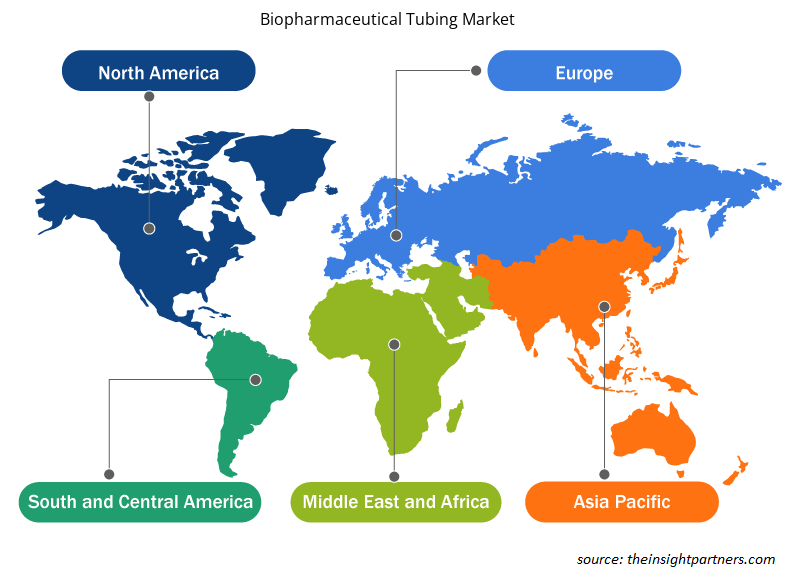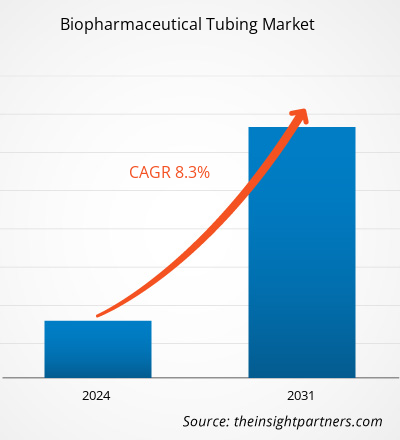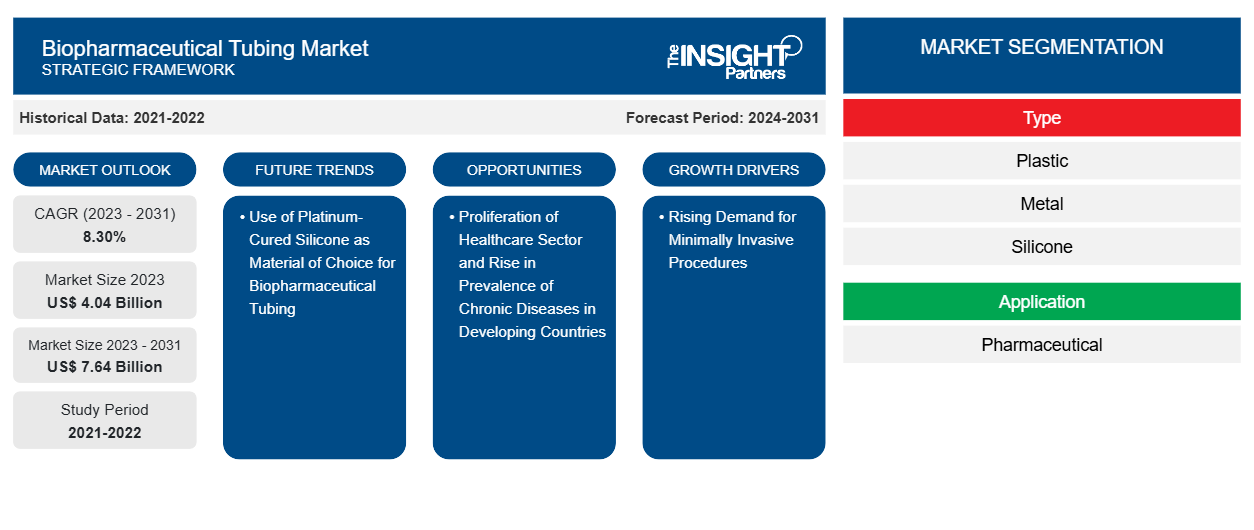Si prevede che la dimensione del mercato dei tubi biofarmaceutici raggiungerà i 7,64 miliardi di dollari entro il 2031, rispetto ai 4,04 miliardi di dollari del 2023. Si prevede che il mercato registrerà un CAGR dell'8,30% nel periodo 2023-2031. Il silicone polimerizzato al platino come materiale di scelta per i tubi biofarmaceutici rimarrà probabilmente una tendenza chiave nel mercato.biopharmaceutical tubing market size is projected to reach US$ 7.64 billion by 2031 from US$ 4.04 billion in 2023. The market is expected to register a CAGR of 8.30% during 2023–2031. Platinum-cured silicone as the material of choice for biopharmaceutical tubing will likely remain a key trend in the market.
Analisi del mercato dei tubi biofarmaceuticiBiopharmaceutical Tubing Market Analysis
I tubi biofarmaceutici sono un mercato consolidato. Tuttavia, poiché c'è una crescente attenzione verso migliori risultati delle procedure chirurgiche e condizioni correlate, si prevede che cresceranno più rapidamente. I principali fattori che guidano l'espansione del mercato sono il crescente numero di procedure minimamente invasive e la domanda in forte aumento di dispositivi medici che utilizzano tubi nell'area.
Secondo le stime, si prevede che il mercato dei tubi biofarmaceutici crescerà più rapidamente in Asia. L'invecchiamento della popolazione, i prodotti farmaceutici e la disponibilità di materie plastiche di qualità medica a prezzi ragionevoli miglioreranno significativamente le prospettive di profitto.
Panoramica del mercato dei tubi biofarmaceutici
Un aumento dell'aspettativa di vita sta contribuendo alla popolazione geriatrica globale. L'Organizzazione Mondiale della Sanità (OMS) prevede che entro il 2050 la percentuale di adulti over 60 in tutto il mondo quasi raddoppierà, dal 12% del 2015 al 22%. Il rapporto World Population Ageing 2017 delle Nazioni Unite afferma che nel 2017 c'erano 962 milioni di adulti nel mondo che avevano 60 anni o più. Si prevede che tale cifra salirà a circa 2,1 miliardi entro il 2050. Inoltre, l'US Census Bureau prevede che la popolazione di americani di 65 anni e più aumenterà da 46 milioni nel 2016 a oltre 98 milioni entro il 2060, aumentando la loro quota di popolazione da circa il 15% a circa il 24% durante questo periodo. L'Europa ha la percentuale più significativa di adulti over 60 (25%), secondo il rapporto World Population Ageing 2017 delle Nazioni Unite. Una parte considerevole della popolazione in ogni regione del mondo, eccetto l'Africa, avrà 60 anni o più entro il 2050 a causa dell'accelerazione dell'invecchiamento globale. Entro il 2030, 2050 e 2100, rispettivamente, si prevede che la popolazione geriatrica globale ammonterà a 1,4 miliardi di dollari USA, 2,1 miliardi di dollari USA e oltre 3,1 miliardi di dollari USA. L'invecchiamento della popolazione sta causando un aumento delle malattie geriatriche, che a sua volta sta facendo aumentare la domanda di sistemi di somministrazione di farmaci e strumenti diagnostici.Ageing 2017 report from the United Nations states that there were 962 million adults in the world in 2017 who were 60 or older. That figure is projected to rise to approximately 2.1 billion by 2050. Furthermore, the US Census Bureau projects that the population of Americans 65 and older will increase from 46 million in 2016 to over 98 million by 2060, increasing their population share from approximately 15% to approximately 24% during this time. Europe has the most significant proportion of adults over 60 (25%), according to the United Nations World Population Ageing 2017 report. A considerable portion of the population in every region of the world, except Africa, will be 60 or older by 2050 due to the acceleration of global aging. By 2030, 2050, and 2100, respectively, the global geriatric population is projected to amount to US$ 1.4 billion, US$ 2.1 billion, and more than US$ 3.1 billion. The aging population is causing a rise in geriatric illnesses, which in turn is driving up demand for medication delivery systems and diagnostic tools.
Inoltre, sta contribuendo all'aumento della prevalenza di disturbi urologici che necessitano di cateterizzazione. Inoltre, i medici stanno spingendo per l'autocateterizzazione per ridurre i ricoveri ospedalieri e i costi, riducendo al contempo il rischio di infezioni legate all'assistenza sanitaria (HAI). Un fattore critico che contribuisce all'aumento delle malattie croniche che possono richiedere interventi che comportano il ricovero in terapia intensiva è l'invecchiamento. L'adozione di sistemi di tubi biofarmaceutici è quindi guidata dalla rapida crescita della popolazione geriatrica, che è direttamente correlata alla crescente domanda di dispositivi medici che incorporano tubi, somministrazione di farmaci, dialisi, bypass cardiaco, pompa peristaltica e sistemi di riempimento e distribuzione sterili.self-catheterization to lower hospital stays and costs while lowering the risk of infections linked to healthcare (HAI). A critical contributing factor to the rise in chronic illnesses that may necessitate interventions involving ICU admission is aging. The adoption of biopharmaceutical tubing systems is thus driven by the rapid growth in the geriatric population, which is directly correlated with the growing demand for medical devices that incorporate tubing, drug delivery, dialysis, cardiac bypass, peristaltic pump, and sterile filling and dispensing systems.
Personalizza questo report in base alle tue esigenze
Riceverai la personalizzazione gratuita di qualsiasi report, comprese parti di questo report, o analisi a livello nazionale, pacchetto dati Excel, oltre a usufruire di grandi offerte e sconti per start-up e università
- Scopri le principali tendenze di mercato in questo rapporto.Questo campione GRATUITO includerà analisi di dati che spaziano dalle tendenze di mercato alle stime e alle previsioni.
Driver e opportunità del mercato dei tubi biofarmaceutici
La crescente domanda di procedure minimamente invasive favorisce la crescita del mercato
Un piccolo dispositivo o un impianto viene solitamente inserito nel corpo attraverso un'incisione o un'altra apertura anatomica durante una procedura medica minimamente invasiva. Queste procedure sono diventate sempre più popolari perché comportano piccole incisioni, i pazienti guariscono più rapidamente e i pazienti provano meno disagio. Inoltre, queste operazioni sono collegate a vantaggi come dolore ridotto, danni minimi ai tessuti e meno traumi a muscoli, nervi, tessuti e organi.
La necessità di procedure meno invasive è aumentata a causa della crescente incidenza di cancro, malattie cardiache e artrite, tutte patologie che richiedono lunghi trattamenti chirurgici. Cateteri e tubi biofarmaceutici, tra gli altri componenti, sono molto richiesti. I sistemi di tubi biofarmaceutici aiutano anche con procedure che fanno risparmiare tempo e hanno prezzi ragionevoli. Ad esempio, il tempo necessario per la procedura medica o chirurgica è notevolmente ridotto quando i tubi del catetere vengono utilizzati per la cateterizzazione cardiaca e urinaria. Pertanto, la crescente necessità di procedure mediche meno invasive e l'enfasi nel rendere queste procedure più efficienti sono fattori significativi che guidano il mercato dei tubi biofarmaceutici.
La proliferazione del settore sanitario e l'aumento della prevalenza delle malattie croniche nei paesi in via di sviluppo creano opportunità significative nel mercato
La prevalenza delle malattie croniche è in aumento nei paesi in via di sviluppo a causa di cambiamenti significativi e graduali nello stile di vita. Inoltre, la prevalenza di altre condizioni di salute, come i disturbi professionali, è in aumento a causa dell'adozione di culture e infrastrutture di lavoro moderne. Le strutture moderne inducono i loro occupanti a impegnarsi in meno attività fisica, ma l'intensa concorrenza nel mercato contribuisce anche ad aumentare i livelli di stress. Pertanto, la necessità di cateteri e tubi biofarmaceutici aumenterà in queste economie man mano che la prevalenza delle malattie croniche aumenta e più persone cercano assistenza medica. Le economie di Brasile, India, Russia, Cina e Sudafrica (BRICS) sono tra quelle in più rapida crescita al mondo. L'invecchiamento della popolazione, i cambiamenti nella domanda dei clienti e la maggiore consapevolezza dei servizi sanitari dovrebbero tutti contribuire alla rapida espansione prevista dei settori sanitari in queste e altre economie in via di sviluppo a breve. Si prevede che il mercato dei tubi biofarmaceutici avrà un potenziale sostanziale nei prossimi anni a causa della crescita di questo settore. Si prevede inoltre che lo sviluppo del settore sanitario e del mercato dei tubi biofarmaceutici sarà favorito dalla maggiore spesa pubblica per le strutture sanitarie e dall'aumento del potere d'acquisto dei consumatori.biopharmaceutical tubing will rise in these economies as the prevalence of chronic diseases increases and more people seek medical attention. The economies of Brazil, India, Russia, China, and South Africa (BRICS) are some of the fastest-growing in the world. The aging population, changes in customer demand, and increased awareness of healthcare services are all expected to contribute to the projected rapid expansion of the healthcare sectors in these and other developing economies shortly. The biopharmaceutical tubing market is expected to have substantial potential in the upcoming years due to the growth of this industry. The development of the healthcare sector and the biopharmaceutical tubing market is also anticipated to be aided by higher government spending on healthcare facilities and rising consumer purchasing power.
Analisi della segmentazione del rapporto di mercato dei tubi biofarmaceutici Tubing Market Report Segmentation Analysis
I segmenti chiave che hanno contribuito alla derivazione dell'analisi di mercato dei tubi biofarmaceutici sono tipologia e applicazione.biopharmaceutical tubing market analysis are type and application.
- In base al tipo, il mercato dei tubi biofarmaceutici è suddiviso in plastica, metallo e silicone. Il segmento del silicone ha detenuto la quota di mercato più significativa nel 2023.biopharmaceutical tubing market is divided into plastic, metal, and silicone. The silicone segment held the most significant market share in 2023.
- Per applicazione, il mercato è categorizzato in farmaceutico {tecnologia monouso e altri, ricerca e sviluppo, dispositivi medici e altri. Il segmento farmaceutico ha detenuto la quota maggiore del mercato nel 2023.
Analisi della quota di mercato dei tubi biofarmaceutici per area geografica Tubing Market Share Analysis by Geography
L'ambito geografico del rapporto sul mercato dei tubi biofarmaceutici è suddiviso principalmente in cinque regioni: Nord America, Asia Pacifico, Europa, Medio Oriente e Africa, e Sud e Centro America.
Il Nord America è composto da tre paesi: Stati Uniti, Canada e Messico. Gli Stati Uniti detenevano la quota maggiore della crescente domanda di dispositivi medici che incorporano tubi. Si prevede che l'adozione di dispositivi medici avanzati, i progressi tecnologici e un passaggio a procedure mediche minimamente invasive accelereranno la crescita del mercato dei tubi biofarmaceutici. Inoltre, gli operatori del mercato stanno adottando strategie di crescita organiche e inorganiche per lo sviluppo del mercato. Ad esempio, a novembre 2019, Saint-Gobain Life Sciences ha completato la costruzione del suo nuovo stabilimento a Largo, in Florida, segnando un'altra pietra miliare fondamentale nella sua iniziativa di espansione mondiale da 70 milioni di euro, che vedrà sette sedi di produzione costruite e operative entro la fine del 2020. La struttura di 80.000 piedi quadrati di Largo, in Florida, diventerà un ulteriore sito di produzione per i tubi C-Flex di Saint-Gobain, le connessioni stampate e gli assemblaggi utilizzati nella gestione dei fluidi per la produzione biofarmaceutica. Saint-Gobain continuerà a produrre i tubi C-Flexs e le linee di prodotti correlate nei suoi stabilimenti esistenti di Clearwater, Florida, Charny, Francia e Bangalore, India.
Analogamente, a marzo 2017, AdvantaPure ha lanciato il marchio AdvantaSil di tubi e flessibili in silicone. I prodotti AdvantaSil per tubi e flessibili in silicone sono destinati a processi monouso, dal tubo rinforzato, al tubo non rinforzato, al tubo di aspirazione rinforzato con filo e al tubo di grado pompa. I prodotti sono progettati e testati per i settori farmaceutico e biofarmaceutico.
Pertanto, a causa dei fattori sopra menzionati, si prevede che il mercato dei tubi biofarmaceutici crescerà nei prossimi anni nel paese
Approfondimenti regionali sul mercato dei tubi biofarmaceutici
Le tendenze regionali e i fattori che influenzano il mercato dei tubi biofarmaceutici durante il periodo di previsione sono stati ampiamente spiegati dagli analisti di Insight Partners. Questa sezione discute anche i segmenti e la geografia del mercato dei tubi biofarmaceutici in Nord America, Europa, Asia Pacifico, Medio Oriente e Africa e Sud e Centro America.

- Ottieni i dati specifici regionali per il mercato dei tubi biofarmaceutici
Ambito del rapporto sul mercato dei tubi biofarmaceutici
| Attributo del report | Dettagli |
|---|---|
| Dimensioni del mercato nel 2023 | 4,04 miliardi di dollari USA |
| Dimensioni del mercato entro il 2031 | 7,64 miliardi di dollari USA |
| CAGR globale (2023-2031) | 8,30% |
| Dati storici | 2021-2022 |
| Periodo di previsione | 2024-2031 |
| Segmenti coperti | Per tipo
|
| Regioni e Paesi coperti | America del Nord
|
| Leader di mercato e profili aziendali chiave |
|
Densità degli attori del mercato dei tubi biofarmaceutici: comprendere il suo impatto sulle dinamiche aziendali
Il mercato dei tubi biofarmaceutici sta crescendo rapidamente, spinto dalla crescente domanda degli utenti finali dovuta a fattori quali l'evoluzione delle preferenze dei consumatori, i progressi tecnologici e una maggiore consapevolezza dei benefici del prodotto. Con l'aumento della domanda, le aziende stanno ampliando le loro offerte, innovando per soddisfare le esigenze dei consumatori e capitalizzando sulle tendenze emergenti, il che alimenta ulteriormente la crescita del mercato.
La densità degli operatori di mercato si riferisce alla distribuzione di aziende o società che operano in un particolare mercato o settore. Indica quanti concorrenti (operatori di mercato) sono presenti in un dato spazio di mercato in relazione alle sue dimensioni o al valore di mercato totale.
Le principali aziende che operano nel mercato dei tubi biofarmaceutici sono:
- WL Gore and Associates, Inc.
- Sicurezza Saint-Gobain
- Gruppo Freudenberg
- RAUMEDIC AG
- TECNOLOGIA PLEX
- Società anonima NewAge Industries, Inc.
Disclaimer : le aziende elencate sopra non sono classificate secondo un ordine particolare.

- Ottieni una panoramica dei principali attori del mercato dei tubi biofarmaceutici
Notizie e sviluppi recenti sul mercato dei tubi biofarmaceutici
Il mercato dei tubi biofarmaceutici viene valutato raccogliendo dati qualitativi e quantitativi post-ricerca primaria e secondaria, che includono importanti pubblicazioni aziendali, dati di associazioni e database. Di seguito sono elencati alcuni degli sviluppi nel mercato dei tubi biofarmaceutici:
- DuPont sta accelerando i suoi investimenti per il futuro dell'industria di trasformazione biofarmaceutica espandendo la sua capacità di fornitura di elastomeri e tubi in silicone e ampliando le sue linee di prodotti farmaceutici monouso con nuovi tubi in elastomero termoplastico (TPE) (Fonte: DuPont, comunicato stampa, aprile 2022)
- Optinova ha aperto il suo stabilimento Optinova Valley Forge. La nuova fabbrica è un investimento per aumentare significativamente la capacità produttiva di soluzioni di tubi industriali speciali. Optinova Valley Forge può ospitare oltre 20 linee di estrusione alla massima capacità e avere 11 linee di estrusione attive. (Fonte: Optinova, comunicato stampa, maggio 2021)
Copertura e risultati del rapporto sul mercato dei tubi biofarmaceutici
Il rapporto "Dimensioni e previsioni del mercato dei tubi biofarmaceutici (2021-2031)" fornisce un'analisi dettagliata del mercato che copre le seguenti aree:
- Dimensioni e previsioni del mercato dei tubi biofarmaceutici a livello globale, regionale e nazionale per tutti i principali segmenti di mercato coperti dall'ambito
- Tendenze del mercato dei tubi biofarmaceutici e dinamiche di mercato come driver, vincoli e opportunità chiave
- Analisi dettagliata delle cinque forze PEST/Porter e SWOT
- Analisi del mercato dei tubi biofarmaceutici che copre le principali tendenze del mercato, il quadro globale e regionale, i principali attori, le normative e i recenti sviluppi del mercato.
- Analisi del panorama industriale e della concorrenza che copre la concentrazione del mercato, l'analisi della mappa di calore, i principali attori e gli sviluppi recenti per il mercato dei tubi biofarmaceutici
- Profili aziendali dettagliati
- Analisi storica (2 anni), anno base, previsione (7 anni) con CAGR
- Analisi PEST e SWOT
- Valore/volume delle dimensioni del mercato - Globale, Regionale, Nazionale
- Industria e panorama competitivo
- Set di dati Excel
Report recenti
Rapporti correlati
Testimonianze
Motivo dell'acquisto
- Processo decisionale informato
- Comprensione delle dinamiche di mercato
- Analisi competitiva
- Analisi dei clienti
- Previsioni di mercato
- Mitigazione del rischio
- Pianificazione strategica
- Giustificazione degli investimenti
- Identificazione dei mercati emergenti
- Miglioramento delle strategie di marketing
- Aumento dell'efficienza operativa
- Allineamento alle tendenze normative





















 Ottieni un campione gratuito per - Mercato dei tubi biofarmaceutici
Ottieni un campione gratuito per - Mercato dei tubi biofarmaceutici